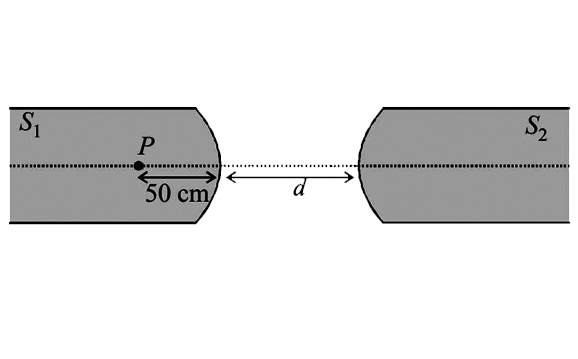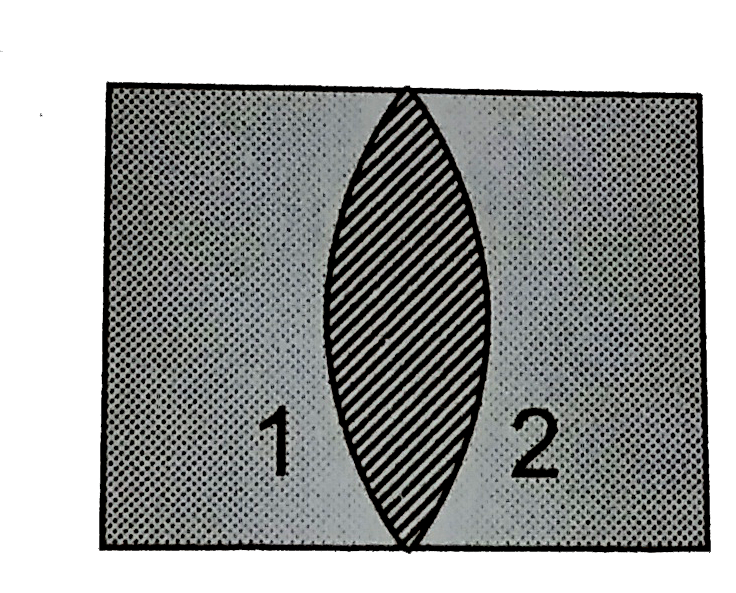Two identical glass rods S1 and S2 (refractive index=1.5) have one convex end of radius of curvature 10 cm. They are placed with the curved surfaces at a distance d as shown in the figure, with their axes (shown by the dashed line) aligned. When a point source of light P is placed inside rod S1 on its axis at a distance of 50 cm from the curved face, the light rays emenating from it are found to be parallel to the axis inside S2. The distance d is

60 cm to the left of the system
70 cm
80 cm
90 cm
The correct Answer is:B
_E01_231_S01.png)
For first surface
1V−1.5−50=1−1.5−10⇒V=50cm
for second surfaces
1∞−1−(d−50)=1.5−110
d = 70 cm ∴(B)
Topper's Solved these Questions
- BOOK - ALLENCHAPTER - GEOMETRICAL OPTICSEXERCISE - MCQ5videos
GEOMETRICAL OPTICS
- BOOK - ALLENCHAPTER - GEOMETRICAL OPTICSEXERCISE - MATCHING2videos
GEOMETRICAL OPTICS
- BOOK - ALLENCHAPTER - GEOMETRICAL OPTICSEXERCISE - EXERCISE-05 (A)35videos
GEOMETRICAL OPTICS
- BOOK - ALLENCHAPTER - CURRENT ELECTRICITYEXERCISE - All Questions427videos
CURRENT ELECTRICITY
- BOOK - ALLENCHAPTER - GRAVITATIONEXERCISE - EXERCISE 49videos
GRAVITATION
Similar Questions
A glass dumbbell of length 30cm and refractive index 1.5 has ends of radius of curvature 3cm. A point object is situated at a distance of 12cm from one end of dumbbell. Find the position of the image formed due to refraction ai one end only.
View SolutionA double convex spherical glass has refractive index 1.5 and both radius of curvature 30 cm. A point object is placed at a distance of 120 cm from the spherical glass. What will be the position of the image formed ?
View Solution
Knowledge Check
- Question 1 - Select One

Two plano-concave lenses (1 and 2) of glass of refractive index 1.5 have radii of curvature 25 cm and 20 cm. They are placed in contact with their curved surface towards each other and the space betweent hem is filled with liquid of refractive index 43 the the combination isAconvex lens of focal length 70 cmBconcave lens of focal length 70 cmCconcave lens of focal length 66.6 cmDconvex lens of focal length 66.6 cm - Question 2 - Select One
Two identical thin planoconvex glass lenses (refractive index 1.5) each having radius of curvature of 20cm are placed with their convex surfaces in contact at the centre. The intervening space is filled with oil of refractive index 1.7. The focal length of the combination is
A−20cmB−25cmC−50cmD50cm - Question 3 - Select One

Two plano-concave lenses (1 and 2) of glass of refractive index 1.5 have radii of curvature 25 cm and 20 cm. They are placed in contact with their curved surface towards each other and the space betweent hem is filled with liquid of refractive index 43 the the combination isAconvex of focal length 70 cmBconcave of focal length 70 cmCconcave of focal length 66.6 cmDconvex of focal length 66.6 cm
There is a glass (μ=1.5) biconvex lens of radius of curvature 5 cm and thickness of the lens is also 5 cm. An object is placed at a distance 20 cm from the front surface of lens. Locate its final image.
View SolutionAn image is formed at a distance of 100 cm from the glass surface with refractive index 1.5, when a point object is placed in the air at a distance of 100 cm from the glass surface. The radius of curvature is of the surface is
View SolutionA double convex lens is made of glass of refractive index 1.5. If its focal length is 30 cm, then radius of curvature of each of its curved surface is
View SolutionA plano-concave lens is made of glass of refractive index 1.5 and the radius of curvature of its curved face is 100 cm. What is the power of the lens?
View SolutionA plano convex lens of refractive index 1.5 and radius of curvature 30cm. Is silvered at the curved surface. Now this lens has been used to form the image of an object. At what distance from this lens an object be placed in order to have a real image of size of the object.
View Solution

